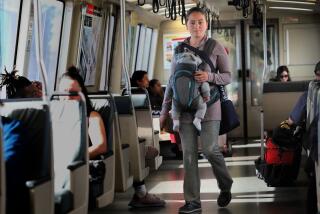Dial-a-Ride Abused, OCTD Director Says
- Share via
Concern over costs prompted the transit board to delay a scheduled increase in dial-a-ride pending long-range review of the service.
Too many dial-a-ride customers are youths going to video and music stores, and the curb-to-curb van service should be restricted to the handicapped and the elderly, two Orange County Transit District board members charged Monday.
Supervisors Roger R. Stanton and Don R. Roth, who sit on the OCTD board, said the service--now available by appointment to anyone--is a “luxury” that is being abused by students and others who could walk to the nearest regular OCTD bus stop.
Stanton said the district could save about $6 million a year--if OCTD allows the elderly and handicapped to ride the vans for free--by ending the costly service provided to others. In an interview later, however, Stanton said the savings might be less--perhaps $3 million--but still worth pursuing.
OCTD Chairman William E. Farris and other board members said they were leaning against such action, but they have reserved judgment until the agency’s staff analyzes how such a change would affect transit service overall.
Farris complained that Roth’s reference to youths using the service to exchange videotapes at local stores in his affluent Anaheim Hills neighborhood was as misleading as President Reagan’s “story about welfare queens driving Cadillacs.”
Farris, who also lives in Anaheim Hills, said he sees maid service employees who are using dial-a-ride. Stanton replied sharply that he considers such use of dial-a-ride an abuse.
Farris replied that “demand-response” transit service is appropriate where fixed-route service is unavailable or too difficult to use.
Currently, the district is conducting a long-range review of dial-a-ride that is scheduled for completion in September.
However, Stanton said he does not want to wait for the September report and probably will ask the board to adopt his proposed service change during the June 15 meeting, at which the district’s annual budget is scheduled for approval.
Partly to meet board members’ complaints about rising operating costs and ridership subsidies for dial-a-ride, the OCTD staff recommended and received board approval Monday for a delay in a scheduled increase in dial-a-ride service until the long-range review is completed.
Currently, dial-a-ride has about 1.4 million boardings annually. Fares are $1.50 during rush hours and $1.25 at other times, while the disabled and elderly pay 50 cents at any time. OCTD’s cost per dial-a-ride passenger has increased to $5.03 from $4.12 in 1984-85, while revenue per passenger has increased to 67 cents from the 1984-85 average of 59 cents.
A one-week OCTD survey in March showed that 28.1% of dial-a-ride trips were taken for shopping, 16.3% for medical purposes and 17.4% for transportation to and from work. Another 11.5% were school- or training-related, 6.9% involved recreation and 19.8% were for other purposes.
Stanton said he had no figures showing how many youths summon vans to get to record stores, but even if no one did, he said, the mere fact that anyone could use the system for that purpose makes it “wrong.”
On another subject, board members were treated to praise from one rider. Wheelchair-bound Harry (Hap) Bayley told board members that without wheelchair lifts on OCTD buses, he would not have been able to attend classes, become a travel agent and get to work.
Bayley gave the board his thanks, his recommendation that OCTD continue to aid the disabled, and, finally, his business cards.
And facing a 1993 federal deadline, the five-member board followed Bayley’s advice. It adopted a plan to make the entire 575-vehicle OCTD fleet wheelchair compatible by 1991.
However, the board also voted to seek new federal rules aimed at standardizing wheelchair designs because, OCTD officials said, too many wheelchairs do not fit the lifts available from manufacturers.
Under federal law, transit districts must submit plans by June 23 for achieving 100% wheelchair compatibility within six years of that date or face loss of federal urban mass transit funds.
Currently, 63% or 279 of the district’s 440 buses are equipped with the lifts, as are 97% or 131 of the agency’s 135 dial-a-ride vans, according to an OCTD staff report.
More to Read
Sign up for Essential California
The most important California stories and recommendations in your inbox every morning.
You may occasionally receive promotional content from the Los Angeles Times.













